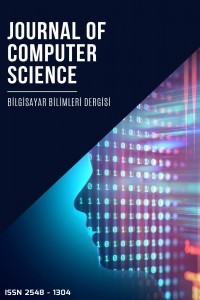Application of Slime Mould Algorithm to Infinite Impulse Response System Identification Problem
IIR adaptive filter, System identification, Slime mould algorithm, Metaheuristic algorithms
Application of Slime Mould Algorithm to Infinite Impulse Response System Identification Problem
IIR adaptive filter, System identification, Slime mould algorithm, Metaheuristic algorithms,
___
- Cuevas, E., Gálvez, J., Hinojosa, S., Avalos, O., Zaldívar, D., & Pérez-Cisneros, M. (2014). A Comparison of Evolutionary Computation Techniques for IIR Model Identification. Journal of Applied Mathematics, 2014, 1–9. https://doi.org/10.1155/2014/827206
- Durmuş, B. (2022). Infinite impulse response system identification using average differential evolution algorithm with local search. Neural Computing and Applications, 34(1), 375–390. https://doi.org/10.1007/s00521-021-06399-4
- Ekinci, S., Izci, D., Zeynelgil, H. L., & Orenc, S. (2020). An Application of Slime Mould Algorithm for Optimizing Parameters of Power System Stabilizer. 2020 4th International Symposium on Multidisciplinary Studies and Innovative Technologies (ISMSIT), 1–5. https://doi.org/10.1109/ISMSIT50672.2020.9254597
- Eswari, P., Ramalakshmanna, Y., & Durga Prasad, C. (2021). An Improved Particle Swarm Optimization-Based System Identification (pp. 137–142). https://doi.org/10.1007/978-981-16-0289-4_11
- Izci, D. (2021). An Enhanced Slime Mould Algorithm for Function optimization. 2021 3rd International Congress on Human-Computer Interaction, Optimization and Robotic Applications (HORA), 1–5. https://doi.org/10.1109/HORA52670.2021.9461325
- Izci, D., & Ekinci, S. (2021). Comparative Performance Analysis of Slime Mould Algorithm For Efficient Design of Proportional–Integral–Derivative Controller. Electrica, 21(1), 151–159. https://doi.org/10.5152/electrica.2021.20077
- Izci, D., Ekinci, S., Eker, E., & Dundar, A. (2021). Assessment of Slime Mould Algorithm Based Real PID Plus Second-order Derivative Controller for Magnetic Levitation System. 2021 5th International Symposium on Multidisciplinary Studies and Innovative Technologies (ISMSIT), 6–10. https://doi.org/10.1109/ISMSIT52890.2021.9604620
- Izci, D., Ekinci, S., Zeynelgil, H. L., & Hedley, J. (2021). Fractional Order PID Design based on Novel Improved Slime Mould Algorithm. Electric Power Components and Systems, 49(9–10), 901–918. https://doi.org/10.1080/15325008.2022.2049650
- Kamboj, V. K., Kumari, C. L., Bath, S. K., Prashar, D., Rashid, M., Alshamrani, S. S., & AlGhamdi, A. S. (2022). A Cost-Effective Solution for Non-Convex Economic Load Dispatch Problems in Power Systems Using Slime Mould Algorithm. Sustainability, 14(5), 2586. https://doi.org/10.3390/su14052586
- Karaboga, N. (2009). A new design method based on artificial bee colony algorithm for digital IIR filters. Journal of the Franklin Institute, 346(4), 328–348. https://doi.org/10.1016/j.jfranklin.2008.11.003
- Kumar, M., Aggarwal, A., & Rawat, T. K. (2016). Bat Algorithm: Application to Adaptive Infinite Impulse Response System Identification. Arabian Journal for Science and Engineering, 41(9), 3587–3604. https://doi.org/10.1007/s13369-016-2222-3
- Li, S., Chen, H., Wang, M., Heidari, A. A., & Mirjalili, S. (2020). Slime mould algorithm: A new method for stochastic optimization. Future Generation Computer Systems, 111, 300–323. https://doi.org/10.1016/j.future.2020.03.055
- Mohammadi, A., Zahiri, S. H., & Razavi, S. M. (2019). Infinite impulse response systems modeling by artificial intelligent optimization methods. Evolving Systems, 10(2), 221–237. https://doi.org/10.1007/s12530-018-9218-z
- Mostafa, M., Rezk, H., Aly, M., & Ahmed, E. M. (2020). A new strategy based on slime mould algorithm to extract the optimal model parameters of solar PV panel. Sustainable Energy Technologies and Assessments, 42, 100849. https://doi.org/https://doi.org/10.1016/j.seta.2020.100849
- Panda, G., Pradhan, P. M., & Majhi, B. (2011). IIR system identification using cat swarm optimization. Expert Systems with Applications, 38(10), 12671–12683. https://doi.org/10.1016/j.eswa.2011.04.054
- Saha, S. K., Kar, R., Mandal, D., & Ghoshal, S. P. (2014). Harmony search algorithm for infinite impulse response system identification. Computers & Electrical Engineering, 40(4), 1265–1285. https://doi.org/10.1016/j.compeleceng.2013.12.016
- Tiachacht, S., Khatir, S., Thanh, C. Le, Rao, R. V., Mirjalili, S., & Abdel Wahab, M. (2021). Inverse problem for dynamic structural health monitoring based on slime mould algorithm. Engineering with Computers. https://doi.org/10.1007/s00366-021-01378-8
- Zhao, R., Wang, Y., Liu, C., Hu, P., Jelodar, H., Yuan, C., Li, Y., Masood, I., Rabbani, M., Li, H., & Li, B. (2020). Selfish herd optimization algorithm based on chaotic strategy for adaptive IIR system identification problem. Soft Computing, 24(10), 7637–7684. https://doi.org/10.1007/s00500-019-04390-9
- ISSN: 2548-1304
- Yayın Aralığı: Yılda 2 Sayı
- Başlangıç: 2016
- Yayıncı: Ali KARCI
Application of Slime Mould Algorithm to Infinite Impulse Response System Identification Problem
Davut İZCİ, Serdar EKİNCİ, Murat GÜLEYDİN
EMG Sinyallerinin HFD Analizi ve Hareket Sınıflandırılması
Gazi AKGÜN, Uğur DEMİR, Alper YILDIRIM
Classification of Skin Cancer with Deep Transfer Learning Method
Doaa Khalid Abdulridha AL-SAEDİ, Serkan SAVAŞ
Akciğer Kanser Tipi Tespitinde Etkili Bir Görüntü Çoğullama Tekniği
Berna ARI, Ömer Faruk ALÇİN, Abdülkadir ŞENGÜR
Derin Öğrenme Tabanlı Görüntü İşleme İle Acil Durum Tespiti
Mustafa GÖKSU, Şafak GÖKSU, Ahmet ALKAN
Evrişimsel Sinir Ağları ile Konuşmadan Duygu Tanıma Sistemi
Metehan AYDİN, Bülent TUĞRUL, Yilmaz AR
Pupil Center Localization Based on Mini U-Net
Jansen Bağlantısının Kinematik Analizi için Araç Kutusu Tasarımı
Semir SÜNKÜN, Berke Oğulcan PARLAK, Alper YILDIRIM, Hüseyin Ayhan YAVAŞOĞLU
